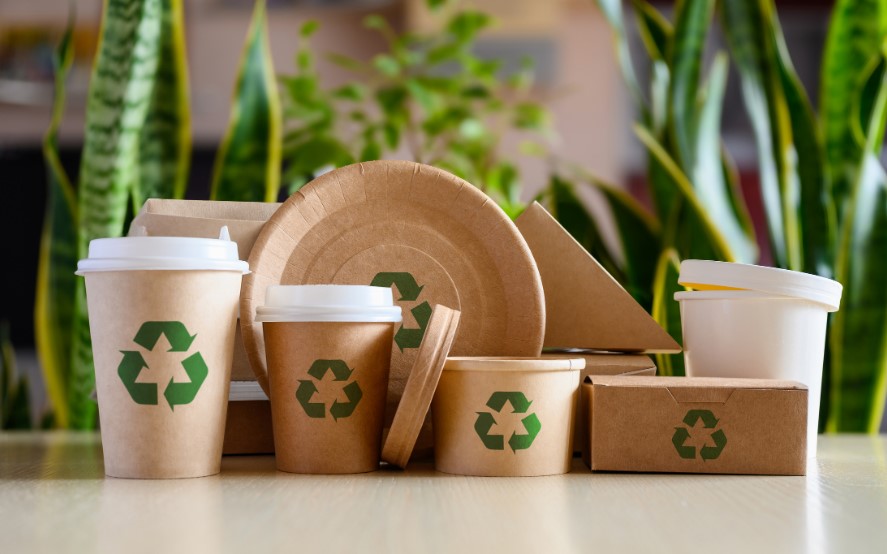Sharing Date3 Oct, 2024

With the development of technology and changes in cultural structure today, almost every product is presented to consumers in packaged form. Packaging serves as the first point of contact with consumers, fulfilling marketing and protection functions, but once these functions are complete, they turn into waste. This highlights the importance of sustainable packaging solutions. Due to the ever-growing world population, the consumption of goods, and thus the consumption of packaged products, is increasing. The rapid increase in consumption harms the natural environment and disrupts the ecological balance.
Since the 1950s, global economic production has continuously increased, and during this period, humanity has consumed natural resources faster than ever before in history. Although there is a growing concern in society about the depletion of these resources, both producers and consumers continue to act under the illusion that resources are unlimited. This reality brings the concept of sustainability to a critical point, especially in industries like packaging design, where natural resource use is intensive.
Most packaging becomes waste after its life cycle ends, causing environmental issues. Increasing consumption rates and environmental threats make the development of more sustainable solutions in packaging design unavoidable. Therefore, it is essential that packaging is designed in a way that minimizes environmental harm. Designing packaging to minimize material use and aligning production with these sensitive designs are among the top priorities for protecting and enhancing the environment.
Packaging designed with reduced material usage is also made suitable for reuse afterward. The concept of sustainability is not only limited to the efficient use of natural resources but also requires designs that minimize waste and facilitate for recycling and secondary use. This approach not only contributes to the conservation of natural resources but also optimizes waste management within the framework of a circular economy. From a sustainable perspective, packaging should be designed to both reduce environmental impact and create economic value.
Sustainability in Packaging Design
Packaging serves to protect products from spoilage while also facilitating transport and storage processes. Additionally, it provides information about the product’s content and quantity, draws consumer attention and functioning as a marketing tool. However, once the product is consumed, the packaging becomes waste and poses a significant burden on the environment. For this reason, sustainability in packaging design is of critical importance.
Sustainable packaging design aims to balance both increasing consumption and rapidly depleting natural resources. This approach focuses on minimizing environmental impact by using natural resources more efficiently, strengthening recycling processes, and promoting reuse methods.
Since 2004, the Sustainable Packaging Coalition (SPC) has made significant strides in promoting sustainable packaging design by collaborating with companies in the packaging industry, public institutions, and educational organizations. SPC defines sustainability as a system that, in line with cradle-to-cradle principles, promotes material flows that use renewable resources and support economic development. The goal of this system is to minimize waste throughout the product’s entire lifecycle and even eliminate it completely. Cradle-to-cradle principles aim for sustainability at every stage of a material’s lifecycle. Packaging produced using this method provides both environmental and economic benefits.
The Sustainable Packaging Coalition highlights that sustainable packaging should possess the following qualities:
- Safe and Healthy Materials: Packaging should be reliable and beneficial to individuals and communities.
- Market Compliance: Packaging should meet market standards in terms of performance and cost.
- Use of Renewable Energy: Packaging should be produced, transported, and recycled using renewable energy.
- Recyclable and Renewable Materials: Priority should be given to maximizing the use of recyclable or renewable materials.
- Environmentally Friendly Production Processes: Packaging should be manufactured using eco-friendly production technologies and best practices.
- Healthy Materials: Packaging should be made from safe materials in end-of-life scenarios.
- Energy and Material Optimization: Maximum efficiency should be achieved in the use of energy and materials.
- Recycling and Reuse: Packaging should be effectively recyclable or reusable in biological or industrial processes.
From the perspective of the listed principles, designers play a crucial role in this process. Each component of the design has the potential to influence the extent and manner in which consumption will occur. While maintaining environmental sensitivity, sustainable packaging must also meet consumer needs. This approach, which aims to meet consumer expectations while reducing negative environmental impacts, is at the heart of the concept of sustainability.
Undoubtedly, consumers also play a vital role in the widespread adoption of eco-friendly packaging. In choosing to food packaging, consumers should prefer the options listed below, as they contribute to sustainability:
- Paper Packaging: Biodegradable paper packaging can decompose within months when discarded in nature. Trees, the raw material of paper, play an important role as sustainable resources. The continual renewal of trees is critical for maintaining environmental balance. Additionally, due to its breathable structure, paper prevents mold growth in many food products. The fact that paper packaging can be recycled up to seven times offers a significant environmental advantage.
- Flexible Packaging: Flexible packaging, which has gained popularity in recent years, contributes to sustainability through lower fossil fuel consumption, reduced greenhouse gas emissions and lower water usage compared to glass or PET packaging, thanks to its lightweight and flexible structure. Made from materials such as foil, plastic, and paper, these packages offer an environmentally friendly alternative by creating a smaller carbon footprint. Used in packaging products like fruit juice and milk, these materials can be separated in recycling processes and reused.
- Glass Packaging: Glass is a material that can be reprocessed and reintegrated into production after use. Scrap glass is resource-efficient because it requires less energy compared to producing new glass from raw materials. Glass packaging, especially for food preservation, offers a safe and healthy option and can be reproduce into production at recycling facilities.
- Bioplastics: Although bioplastics, produced from edible raw materials are a promising alternative to fossil-based plastics, their areas of application, reduction of high production costs, raw material supply and adaption to current technological infrastructure remain subjects of ongoing research.
The fact that packaging cannot only be recycled but also repurposed for other uses after consumption is a factor that enhances sustainability. If packaging can be reused in alternative ways once the product it contains is consumed, it gains a second life. In this way, sustainable packaging design also encompasses designs that allow the packaging to continue serving consumers’ needs after it has been used.
Conclusion
Sustainable packaging design is not limited to simply using sustainable materials; it is also crucial that these designs are transformed into products in a way that minimizes their environmental impact. Packaging should not be seen solely as single-use items but as part of reuse and recycling processes. Supporting recycling culture and spreading this awareness throughout society are crucial steps toward a sustainable future. In this context, prioritizing eco-friendly, long-lasting packaging solutions means contributes to a sustainable future, with consumers playing a significant role in their choices.
References
1) Bilge, L. (2008). More, Bigger, Heavier. Graphic Design Magazine, 25: 52-53.
2) Çeken, B. & Büyükçakılcı, A. (2024). The Concept of Sustainability in Packaging Design. Academic Art Journal, 22, 81-91, p.81. Available at: https://dergipark.org.tr/en/download/article-file/3220665. Last accessed: September 2024.
3) Robertson, G. L. (2013). Food Packaging: Principles and Practice (3rd ed.). Oxfordshire: CRC. Taylor & Francis Group, p.2.
4) Köse, A. (2024). Sustainability and Augmented Reality Use in Food Packaging Design. Işık University, Graduate School of Education, Master’s Thesis in Visual Communication Design, p.31. Available at: https://research.isikun.edu.tr/server/api/core/bitstreams/affa5c01-6189-4fcc-9bb4-6f8009962f81/content. Last accessed: September 2024.
5) The Sustainable Packaging Coalition is a U.S.-based non-profit organization founded in 2004 to promote sustainability practices in the packaging industry. With a broad member network including companies, academic institutions, and government agencies, the coalition aims to develop innovative solutions for sustainable packaging design, production, and recycling. It also conducts research and educational programs to reduce packaging’s environmental impact and promote circular economy principles.
6) Braungart, M. & McDonough, W. (2009). Cradle to Cradle. Random House. Quoted in: Çeken & Büyükçakılcı, op. cit., p.87.
7) DuPuis, S. & Silva, J. (2008). Package Design Workbook: The Art and Science of Successful Packaging. Rockport Publishers. Quoted in: Çeken & Büyükçakılcı, op. cit., p.87.
8) Çeken & Büyükçakılcı, op. cit., p.87.
9) İstanbul Gelişim University, Sustainable Living: Food Packaging. n.d. Available at: https://kalite.gelisim.edu.tr/tr/idari-haber-surdurulebilir-yasam-gida-ambalajlari. Last accessed: September 2024.
10) Ersan, M. (2021). Upcycling as a Sustainable Alternative in Packaging Design. Education and Society Journal of Educational Sciences and Social Research in the 21st Century, 10(30): 679-692, p.688. Available at: https://dergipark.org.tr/tr/download/article-file/2200525. Last accessed: September 2024.

